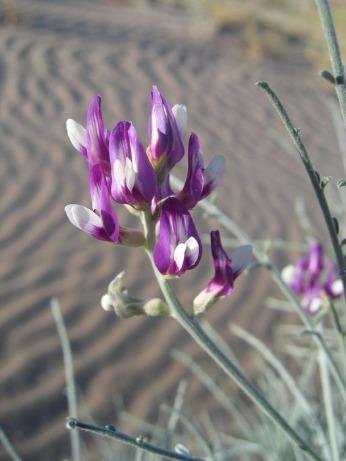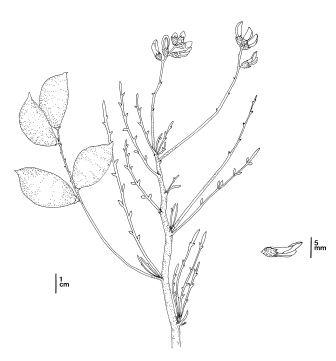(Astragalus magdalenae var. peirsonii)
 Astragalus magdalenae var. peirsonii. Photo © Jordan Zylstra.
Astragalus magdalenae var. peirsonii. Photo © Jordan Zylstra.
 Astragalus magdalenae var. peirsonii. CDFW illustration by Mary Ann Showers. (Click to enlarge)
Astragalus magdalenae var. peirsonii. CDFW illustration by Mary Ann Showers. (Click to enlarge)
Peirson’s milkvetch (Astragalus magdalenae var. peirsonii) is a California endangered plant species, which means that killing or possessing this plant is prohibited by the California Endangered Species Act (CESA). This species is also listed as threatened under the federal Endangered Species Act. Peirson’s milkvetch is a member of the legume family (Fabaceae) and is an erect to spreading, herbaceous, short-lived perennial. It is covered with fine silky hairs and produces purple flowers, often with white tips, which generally appear from December through April. Peirson’s milk-vetch is known from Algodones Dunes in Imperial County, California and the Gran Desierto of northwestern Sonora, Mexico. Within the United States, Peirson’s milkvetch grows in open sand of intact, active windblown sand dunes at Algodones Dunes. It is restricted to specific habitat areas within approximately 53,000 acres in a narrow band running 40 miles northwest to southeast along the western portion of the Algodones Dunes. At the time of this webpage posting, the California Natural Diversity Database (CNDDB) reports only one occurrence of this species, the Algodones Dunes population, which is presumed to still exist within California.
Off-highway vehicle (OHV) use is considered the primary threat to Peirson’s milkvetch. Long-term monitoring indicates that plants exposed to OHV activity have a reduced likelihood of survival. The Algodones Dunes are also referred to as the Imperial Sand Dunes because of their inclusion in the Imperial Sand Dunes Recreation Area (ISDRA), which is a popular OHV area that is largely managed by the Bureau of Land Management (BLM). In 1994, a 32,000 acre area within the dune system was designated as the North Algodones Dunes Wilderness Management Area, a wilderness area designed to protect a number of rare and endemic plant and animal species, including Peirson’s milkvetch. No recreational use of mechanized vehicles is allowed in this wilderness area. Additionally, as a result of a settlement agreement in 2000, BLM agreed to temporarily close five selected areas within the ISDRA, totaling approximately 49,300 acres, to OHV use to protect threatened and endangered species, including Peirson’s milkvetch. In 2004, the U.S. Fish and Wildlife Service designated 21,863 acres as critical habitat for Peirson’s milkvetch; in 2008, the U.S. Fish and Wildlife Service revised the critical habitat designation, reducing it to approximately 12,105 acres. In June 2013, the BLM approved a Recreation Area Management Plan (RAMP) for the ISDRA which will allow much of the closed areas to reopen to OHV use in 2014/2015. Implementation of the RAMP will protect part of the Peirson’s milkvetch population by prohibiting OHV recreation within Peirson’s milkvetch critical habitat, and by maintaining the North Algodones Dunes Wilderness Area as closed to mechanized vehicles.
Although some portions of Peirson’s milkvetch occupied habitat will be protected, OHV use remains the primary threat to unprotected portions of the population. In addition, people occasionally trespass into closed areas with mechanized vehicles. Other potential threats to Peirson’s milkvetch include rodent and insect herbivory, seed predation, habitat fragmentation, and vulnerability to stochastic events due to the species’ limited range.
Long-term survival of Peirson’s milkvetch is dependent upon ensuring that future management actions minimize further impacts to its habitat and individual plants from OHV activities. Large areas of contiguous habitat should be protected, thereby reducing the potential for habitat fragmentation and population isolation. In addition, this species should continue to be monitored to ensure that monitoring efforts continue to assess OHV impacts along with species responses to restrictions and closures of the occupied habitat. Research should be conducted to determine the phylogenetic relationship of Peirson’s milkvetch populations of the Algodones Dunes in California, to those in the Gran Desierto, Sonora, Mexico to clarify its taxonomic status. In addition, research should focus on the species’ breeding system, herbivory, and seed predation threats to this species.
CDFW has participated in the following Peirson’s milkvetch studies through participation in the Cooperative Endangered Species Conservation Fund:
CDFW may issue permits for Peirson’s milkvetch pursuant to CESA, and you can learn more about the California laws protecting Peirson’s milkvetch and other California native plants. Populations of Peirson’s milkvetch occur in CDFW’s Inland Deserts Region. More information is also available from the U.S. Fish and Wildlife Service Species Profile for Peirson’s milkvetch.
Updated 12/8/2015